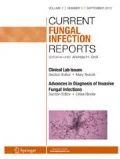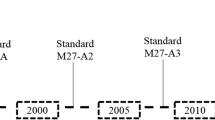Abstract
There are two different approved reference procedures based on microdilution techniques for antifungal susceptibility testing (AFST) of fungal species, the CLSI and the EUCAST procedures. Although there have always been some methodological differences between them, AFST results are comparable. In addition, current breakpoints values of antifungal compounds to interpret AFST results set by both institutions are very similar with some exceptions. Experts advised AFST should be done with validated commercial techniques for a routine daily practice and discrepant results should be confirmed by reference procedures particularly for isolates with borderline/resistant MIC values. Reference methods by EUCAST and CLSI should be also used in periodical epidemiological studies, to evaluate new antifungal agents, new methods of AFST and to know the susceptibility profile of rare and emerging fungal species.
Similar content being viewed by others
References
Papers of particular interest, published recently, have been highlighted as: • Of importance •• Of major importance
Groll AH, Shah PM, Mentzel C, Schneider M, Just-Nuebling G, Huebner K. Trends in the postmortem epidemiology of invasive fungal infections at a university hospital. J Infect. 1996;33(1):23–32.
Martin GS, Mannino DM, Eaton S, Moss M. The epidemiology of sepsis in the United States from 1979 through 2000. N Engl J Med. 2003;348(16):1546–54.
Pinner RW, Teutsch SM, Simonsen L, Klug LA, Graber JM, Clarke MJ, et al. Trends in infectious diseases mortality in the United States. JAMA. 1996;275(3):189–93.
Simonsen L, Conn LA, Pinner RW, Teutsch S. Trends in infectious disease hospitalizations in the United States, 1980–1994. Arch Intern Med. 1998;158(17):1923–8.
• Howard SJ, Cerar D, Anderson MJ, Albarrag A, Fisher MC, Pasqualotto AC, et al. Frequency and evolution of Azole resistance in Aspergillus fumigatus associated with treatment failure. Emerg Infect Dis. 2009;15(7):1068–76. This article is of importance to know the significance of emerging resistance to azole in Aspergillus fumigatus and to estimate the selection of resistant populations due to antimicrobial agents.
Snelders E, Van Der Lee HA, Kuijpers J, Rijs AJ, Varga J, Samson RA, et al. Emergence of azole resistance in Aspergillus fumigatus and spread of a single resistance mechanism. PLoS Med. 2008;5(11):e219.
• Lass-Florl C. The changing face of epidemiology of invasive fungal disease in Europe. Mycoses. 2009;52(3):197–205. This is of importance to know local epidemiology in Europe and frequency of resistant strains.
Balajee SA, Gribskov JL, Hanley E, Nickle D, Marr KA. Aspergillus lentulus sp. nov., a new sibling species of A. fumigatus. Eukaryot Cell. 2005;4(3):625–32.
Balajee SA, Lindsley MD, Iqbal N, Ito J, Pappas PG, Brandt ME. Nonsporulating clinical isolate identified as Petromyces alliaceus (anamorph Aspergillus alliaceus) by morphological and sequence-based methods. J Clin Microbiol. 2007;45(8):2701–3.
Varga J, Houbraken J, Van Der Lee HA, Verweij PE, Samson RA. Aspergillus calidoustus sp. nov., causative agent of human infections previously assigned to Aspergillus ustus. Eukaryot Cell. 2008;7(4):630–8.
Shao PL, Huang LM, Hsueh PR. Recent advances and challenges in the treatment of invasive fungal infections. Int J Antimicrob Agents. 2007;30(6):487–95.
Rodriguez-Tudela JL, Donnelly JP, Pfaller MA, Chryssantou E, Warn P, Denning DW, et al. Statistical analyses of correlation between fluconazole MICs for Candida spp. assessed by standard methods set forth by the European Committee on Antimicrobial Susceptibility Testing (E.Dis. 7.1) and CLSI (M27-A2). J Clin Microbiol. 2007;45(1):109–11.
Espinel-Ingroff A, Barchiesi F, Cuenca-Estrella M, Pfaller MA, Rinaldi M, Rodriguez-Tudela JL, et al. International and multicenter comparison of EUCAST and CLSI M27-A2 broth microdilution methods for testing susceptibilities of Candida spp. to fluconazole, itraconazole, posaconazole, and voriconazole. J Clin Microbiol. 2005;43(8):3884–9.
Cuenca-Estrella M, Lee-Yang W, Ciblak MA, Arthington-Skaggs BA, Mellado E, Warnock DW, et al. Comparative evaluation of NCCLS M27-A and EUCAST broth microdilution procedures for antifungal susceptibility testing of candida species. Antimicrob Agents Chemother. 2002;46(11):3644–7.
Chryssanthou E, Cuenca-Estrella M. Comparison of the EUCAST-AFST broth dilution method with the CLSI reference broth dilution method (M38-A) for susceptibility testing of posaconazole and voriconazole against Aspergillus spp. Clin Microbiol Infect. 2006;12(9):901–4.
Clinical Laboratory Standards Institute. Reference Method for Broth Dilution Antifungal Susceptibility Testing of Yeasts; Approved Standard. CLSI document M27-A. First Edition ed. Wayne, Pennsylvania, USA: Clinical Laboratory Standards Institute; 1997.
Clinical Laboratory Standards Institute. Reference Method for Broth Dilution Antifungal Susceptibility Testing of Yeast; Approved Standard-Third Edition. CLSI document M27-A3. Third Edition ed. Wayne, Pennsylvania, USA: Clinical Laboratory Standards Institute; 2008.
Clinical Laboratory Standards Institute. Reference Method for Broth Dilution Antifungal Susceptibility Testing of Filamentous Fungi; Approved Standard-Second Edition. CLSI document M38-A. Second Edition ed. Wayne, Pennsylvania, USA: Clinical Laboratory Standards Institute; 2002.
Clinical Laboratory Standards Institute. Reference Method for Broth Dilution Antifungal Susceptibility Testing of Filamentous Fungi; Approved Standard-Second Edition. CLSI document M38-A2. Second Edition ed. Wayne, Pennsylvania, USA: Clinical Laboratory Standards Institute; 2008.
•• Arendrup MC, Cuenca-Estrella M, Lass-Florl C, Hope W. EUCAST definitive document EDef 7.2: method for the determination of broth dilution MICs of antifungal agents for yeasts. 2012. Ref Type: Online Source. New document by EUCAST including reference procedures for testing yeasts and quality control procedures.
Subcommittee on Antifungal Susceptibility Testing (AFST) of the ESCMID European Committee for Antimicrobial Susceptibility Testing (EUCAST). EUCAST Technical Note on the method for the determination of broth dilution minimum inhibitory concentrations of antifungal agents for conidiaΓÇôforming moulds. Clinical Microbiology and Infection. 2008;14(10):982–4.
Rex JH, Pfaller MA. Has antifungal susceptibility testing come of age? Clin Infect Dis. 2002;35(8):982–9.
Rex JH, Pfaller MA, Galgiani JN, Bartlett MS, Espinel-Ingroff A, Ghannoum MA, et al. Development of interpretive breakpoints for antifungal susceptibility testing: conceptual framework and analysis of in vitro-in vivo correlation data for fluconazole, itraconazole, and candida infections. Subcommittee on Antifungal Susceptibility Testing of the National Committee for Clinical Laboratory Standards. Clin Infect Dis. 1997;24(2):235–47.
•• Pfaller MA, Diekema DJ, Sheehan DJ. Interpretive breakpoints for fluconazole and Candida revisited: a blueprint for the future of antifungal susceptibility testing. Clin Microbiol Rev. 2006;19(2):435–47. Paper explaining the new procedures by the CLSI to set breakpoint to interpret result of antifungal susceptibility testing.
Pfaller MA, Diekema DJ, Rex JH, Espinel-Ingroff A, Johnson EM, Andes D, et al. Correlation of MIC with outcome for Candida species tested against voriconazole: analysis and proposal for interpretive breakpoints. J Clin Microbiol. 2006;44(3):819–26.
Clinical Laboratory Standards Institute. Reference Method for Broth Dilution Antifungal Susceptibility Testing of Yeasts; Approved Standard. CLSI document M27-A2. Second Edition ed. Wayne, Pennsylvania, USA: Clinical Laboratory Standards Institute; 2002.
• Pfaller MA, Diekema DJ, Andes D, Arendrup MC, Brown SD, Lockhart SR, et al. Clinical breakpoints for the echinocandins and Candida revisited: integration of molecular, clinical, and microbiological data to arrive at species-specific interpretive criteria. Drug Resist Updat. 2011;14(3):164–76. This paper is of importance because the breakpoints by CLSI are revisited and many of them are comparable to those by EUCAST.
• Rodriguez-Tudela JL, Arendrup MC, Cuenca-Estrella M, Donnelly JP, Lass-Florl C. EUCAST breakpoints for antifungals. Drug News Perspect. 2010;23(2):93–7. This is a very useful review by members of the steering committee of the EUCAST about the process to set breakpoints.
Cuesta I, Bielza C, Larranaga P, Cuenca-Estrella M, Laguna F, Rodriguez-Pardo D, et al. Data mining validation of fluconazole breakpoints established by the European Committee on Antimicrobial Susceptibility Testing. Antimicrob Agents Chemother. 2009;53(7):2949–54.
Arendrup MC, Kahlmeter G, Rodriguez-Tudela JL, Donnelly JP. Breakpoints for susceptibility testing should not divide wild-type distributions of important target species. Antimicrob Agents Chemother. 2009;53(4):1628–9.
• Cuesta I, Bielza C, Cuenca-Estrella M, Larranaga P, Rodriguez-Tudela JL. Evaluation by data mining techniques of fluconazole breakpoints established by the Clinical and Laboratory Standards Institute (CLSI) and comparison with those of the European Committee on Antimicrobial Susceptibility Testing (EUCAST). Antimicrob Agents Chemother. 2010;54(4):154–6. This paper includes meta-analysis of breakpoints available and reasons to decrease the former fluconazole breakpoints. Data mining analysis procedures are very well explained.
Cuenca-Estrella M, Gomez-Lopez A, Mellado E, Rodriguez-Tudela JL. Correlation between the procedure for antifungal susceptibility testing for Candida spp. of the European Committee on Antibiotic Susceptibility Testing (EUCAST) and four commercial techniques. Clin Microbiol Infect. 2005;11(6):486–92.
Cuenca-Estrella M, Gomez-Lopez A, Alastruey-Izquierdo A, Bernal-Martinez L, Cuesta I, Buitrago MJ, et al. Comparison of the Vitek 2 antifungal susceptibility system with the clinical and laboratory standards institute (CLSI) and European Committee on Antimicrobial Susceptibility Testing (EUCAST) Broth Microdilution Reference Methods and with the Sensititre YeastOne and Etest techniques for in vitro detection of antifungal resistance in yeast isolates. J Clin Microbiol. 2010;48(5):1782–6.
•• Arendrup MC, Garcia-Effron G, Lass-Florl C, Lopez AG, Rodriguez-Tudela JL, Cuenca-Estrella M, et al. Echinocandin susceptibility testing of Candida species: comparison of EUCAST EDef 7.1, CLSI M27-A3, Etest, disk diffusion, and agar dilution methods with RPMI and isosensitest media. Antimicrob Agents Chemother. 2010;54(1):426–39. Comparisons of reference procedures, commercial and diffusion techniques are included. Good example of standardization processes. Multicenter study.
Cuenca-Estrella M, Gomez-Lopez A, Gutierrez MO, Buitrago MJ, Rodriguez-Tudela JL. Reliability of the WIDERYST susceptibility testing system for detection of in vitro antifungal resistance in yeasts. Antimicrob Agents Chemother. 2008;52(3):1062–5.
Espinel-Ingroff A, Chowdhary A, Cuenca-Estrella M, Fothergill A, Fuller J, Hagen F, et al. Cryptococcus neoformans-Cryptococcus gattii Species Complex: an International Study of Wild-Type Susceptibility Endpoint Distributions and Epidemiological Cutoff Values for Amphotericin B and Flucytosine. Antimicrob Agents Chemother. 2012;56(6):3107–13.
Disclosure
Dr. M. Cuenca-Estrella has received payment for consulting services, expert testimony, and lectures, as well as grant support from Astellas, Gilead, Pfizer, and MSD.
Author information
Authors and Affiliations
Corresponding author
Rights and permissions
About this article
Cite this article
Alastruey-Izquierdo, A., Cuenca-Estrella, M. EUCAST and CLSI: How to Assess in Vitro Susceptibility and Clinical Resistance. Curr Fungal Infect Rep 6, 229–234 (2012). https://doi.org/10.1007/s12281-012-0100-3
Published:
Issue Date:
DOI: https://doi.org/10.1007/s12281-012-0100-3




